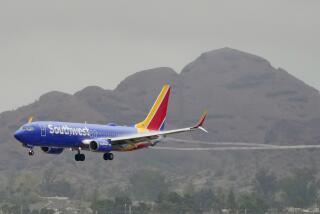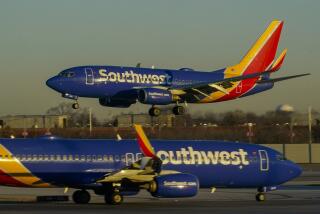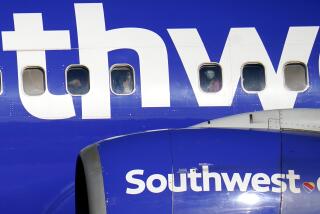Passengers out of comfort zone: Seeking a perfect 10A
You and that pretzel you’re snacking on in the airlines’ cheap seats have something in common: You’re twisted into a shape that’s simply not natural.
Who will stop the pain?
The bad news: Probably not the airlines — at least, not anytime soon.
Consider this: Aircraft designers are dealing with space limitations. A Boeing single-class 767-400ER, for example, can carry a maximum of 375 passengers and handle a maximum takeoff weight of 450,000 pounds. Boeing guidelines, which comply with those of the Federal Aviation Administration, allow for 185 pounds per passenger, 20 of that for carry-on baggage.
But airlines are trying to cope with a range of passenger sizes. As a result, seat design is a compromise, and comfort is now defined as the absence of pain and injury.
“We’re trying to protect a woman a bit under 4 feet 11 and a man 6 feet 3,” says Klaus Brauer, Boeing’s director of passenger satisfaction and revenue.
“In the course of a week, airlines face every conceivable body type on the planet,” says Brauer, who’s 6 feet 1 and 200-plus pounds.
If your economy seat also seems thinner and harder, that may be because it is. Airlines have been installing less padded, lighter seats while complying with an FAA regulation requiring that all aircraft built after October 2009 have seats designed to withstand 16 times the force of gravity (rather than the current nine).
For most passengers, legroom — lack of it — is a big issue, but it isn’t the only one. Headrests can be fixed in “ouch” positions.
And take those “ears” — the projections at each side of the headrest designed to prevent head tilt when a passenger is asleep. They are positioned to be at, or below, the shoulders of tall passengers. “One of those cases,” says Brauer, “in which a well-intentioned enhancement can make [the tallest] passengers quite uncomfortable.”
And as Americans get taller and fatter, they’re bound to “spill into other people’s spaces,” says Peter Budnick, president and chief executive of Park City, Utah-based Ergoweb Inc., an ergonomics consulting and training company that has examined airline seating from the standpoint of both ergonomics and anthropometry — the study of the human body in relation to things people use.
Since the 1960s — the dawn of the jet age — the average American has become an inch taller and 25 pounds heavier, according to a 2004 report (the most recent available) by the national Centers for Disease Control and Prevention that was based on a study charting changes between 1960 and 2002.
The CDC found that in 2002 the average man 20 to 74 years of age was 5 feet 9 1/2 and weighed 191 pounds, while the average woman in the same age range was 5 feet 4 and weighed 164 pounds.
Ideally, seats would be bigger, but more weight means higher fuel costs. As it is, obesity is affecting energy efficiency. In a 2004 article in the American Journal of Preventive Medicine, the CDC estimated that in 2000 alone those added pounds that passengers had packed on since the ‘60s cost airlines $275 million for 350 million more gallons of fuel.
Even the skinniest flier knows that working in flight is, ergonomically speaking, a stiff neck waiting to happen. “The laptop pushed up against your belly is not an ideal computing position,” Budnick says.
Virgin Atlantic Airways took ergonomics and anthropometry into account when it designed its economy and premium economy seats introduced in January. (These are on its two daily L.A.-to-London flights starting this month.)
Traditionally, engineers design seats, making cost and safety their priorities, then designers do their best to make them look nice with, for example, attractive fabrics. But Virgin Atlantic’s new seats were designed by its 15-member in-house team in consultation with London-based PearsonLloyd, known for furniture design. One goal: to make them feel more like chairs. The all-leather premium economy seats are 21 inches wide with a 38-inch pitch (the distance between two rows of seats) and have dual-position footrests. Industrywide, the average pitch is 32 inches.
To create the illusion of more space in regular economy, says Joe Ferry, Virgin Atlantic’s head of design, designers “focused on making the back of the seat in front feel more like it’s a part of” yours. The trick: a carbon-fiber entertainment component housing that covers the seat back, dividing the space. Economy seats move forward and rise as they recline and have adjustable lumbar support and headrest.
“ ‘Challenging’ is too small a word” to describe the task of designing a seat to accommodate the smallest woman or largest man, Ferry says. “Comfort is very difficult to measure,” he says. “What we’re measuring is discomfort, trying to eliminate that as much as possible.”
Boeing’s design team found that cabin design may distract passengers from the realities of economy seats. When Boeing rolls out its 250-seat 787 in May 2008 and its 467-seat 747-8 in 2010, they will be designed with larger windows to enable passengers to see above the horizon. Overhead bins washed in white light to resemble clouds and ceilings illuminated in blue — as in sky — will evoke “what people might see if they could fly without our help,” Brauer says.
Till then, passengers can make flying more comfortable by browsing hundreds of seat maps at https://www.seatguru.com . The site can help them learn which seats to avoid (noisy, right by a lavatory) and which to snap up (exit, bulkhead).
With these tools, maybe you can take it sitting down.
beverly.beyette@latimes.com
More to Read
Sign up for The Wild
We’ll help you find the best places to hike, bike and run, as well as the perfect silent spots for meditation and yoga.
You may occasionally receive promotional content from the Los Angeles Times.






